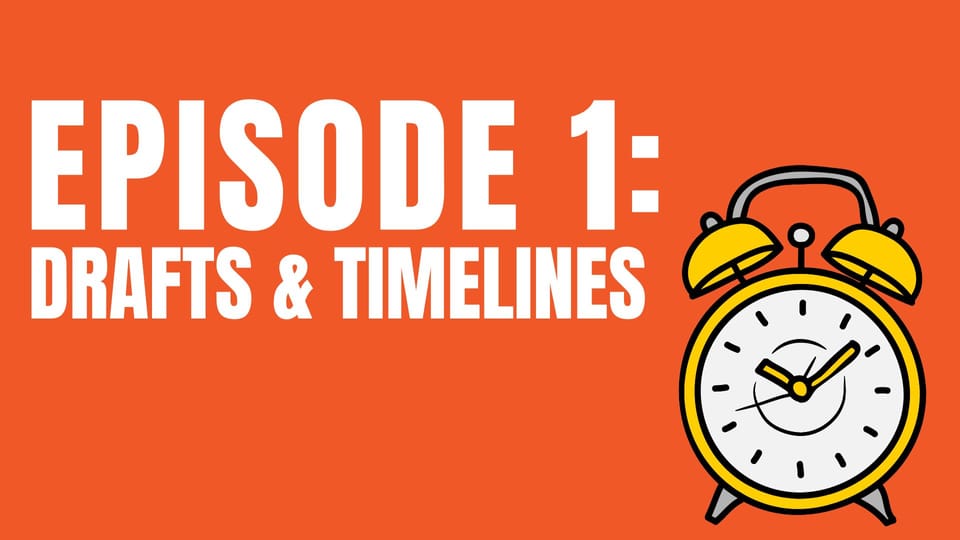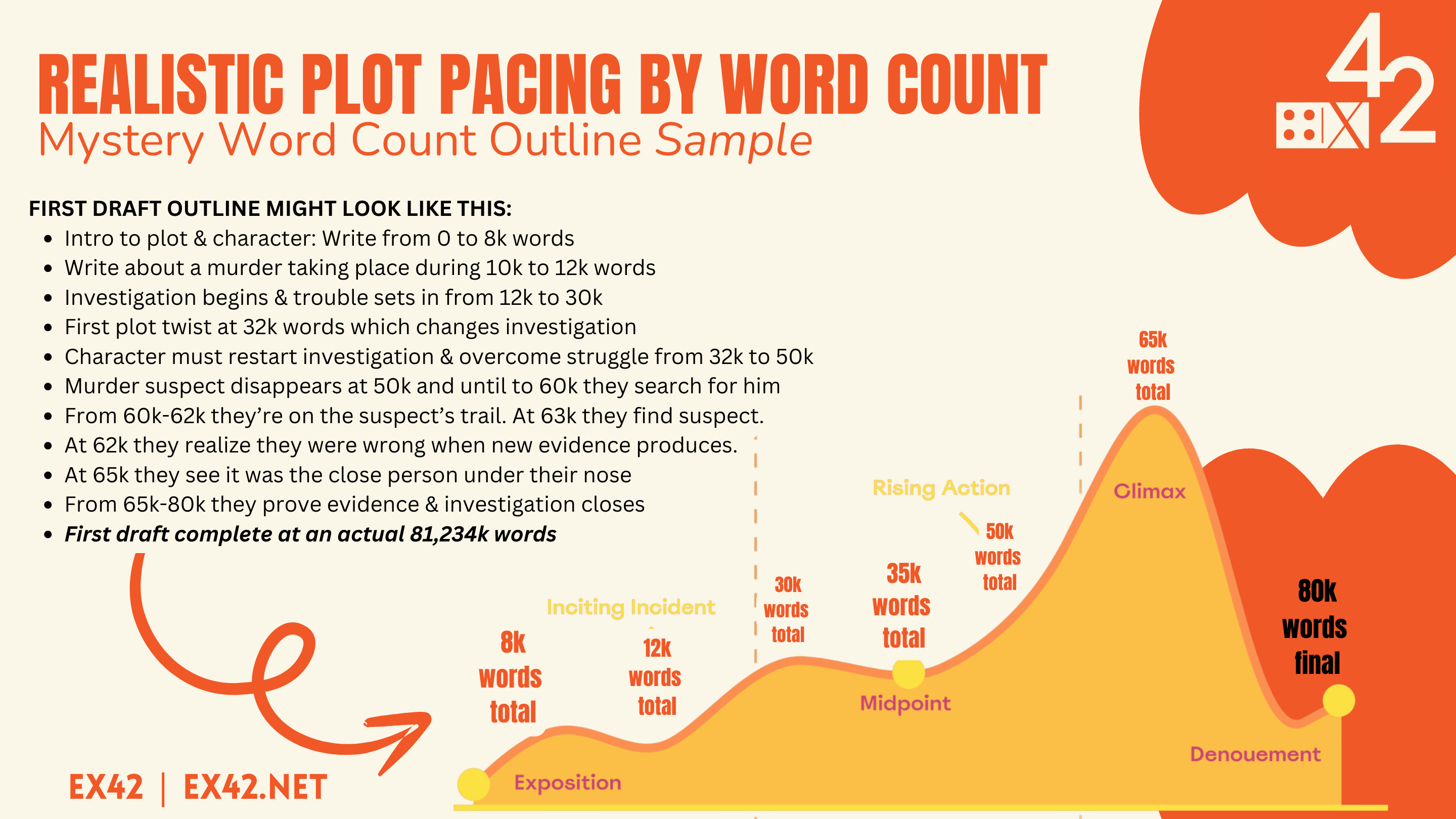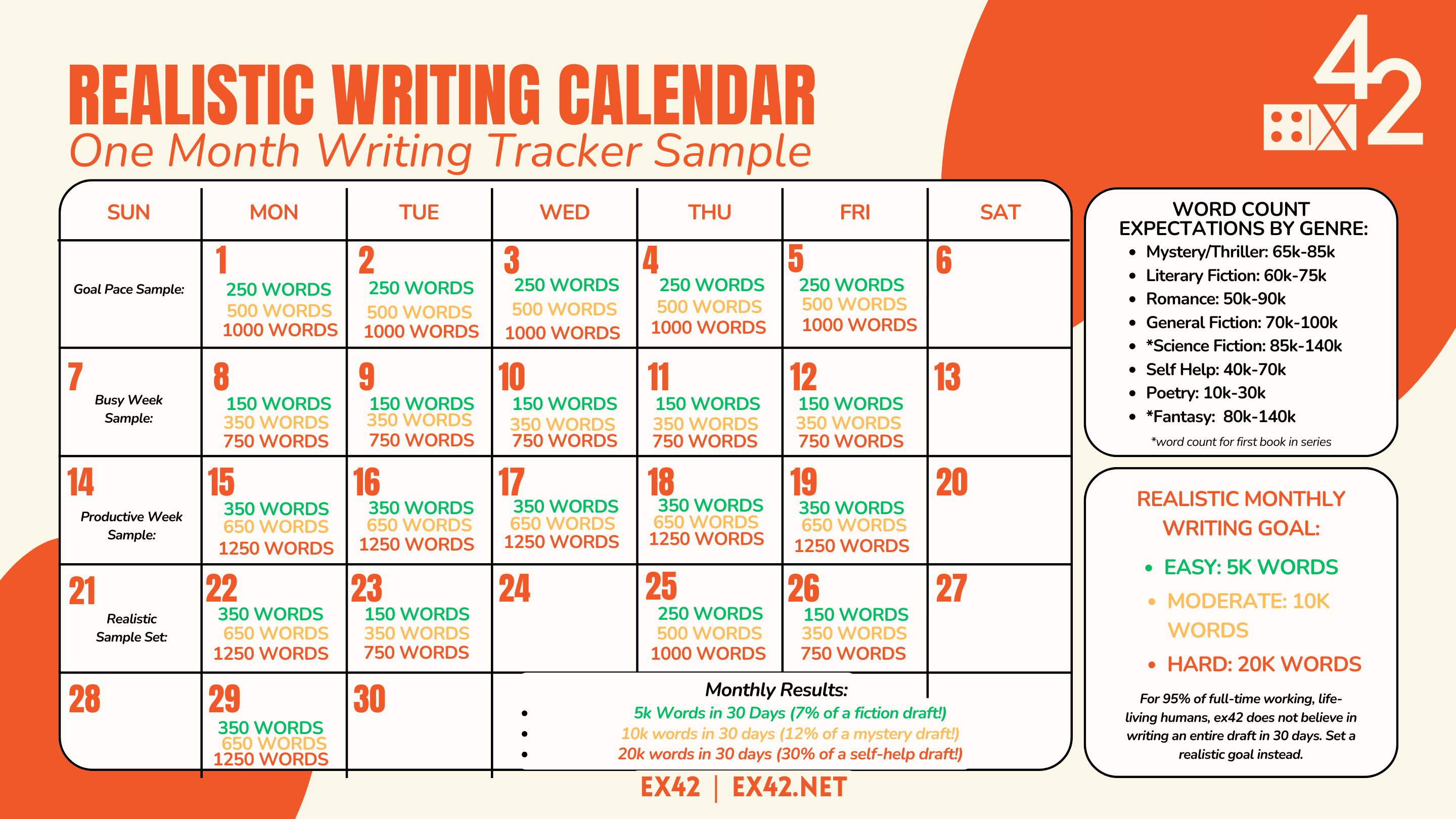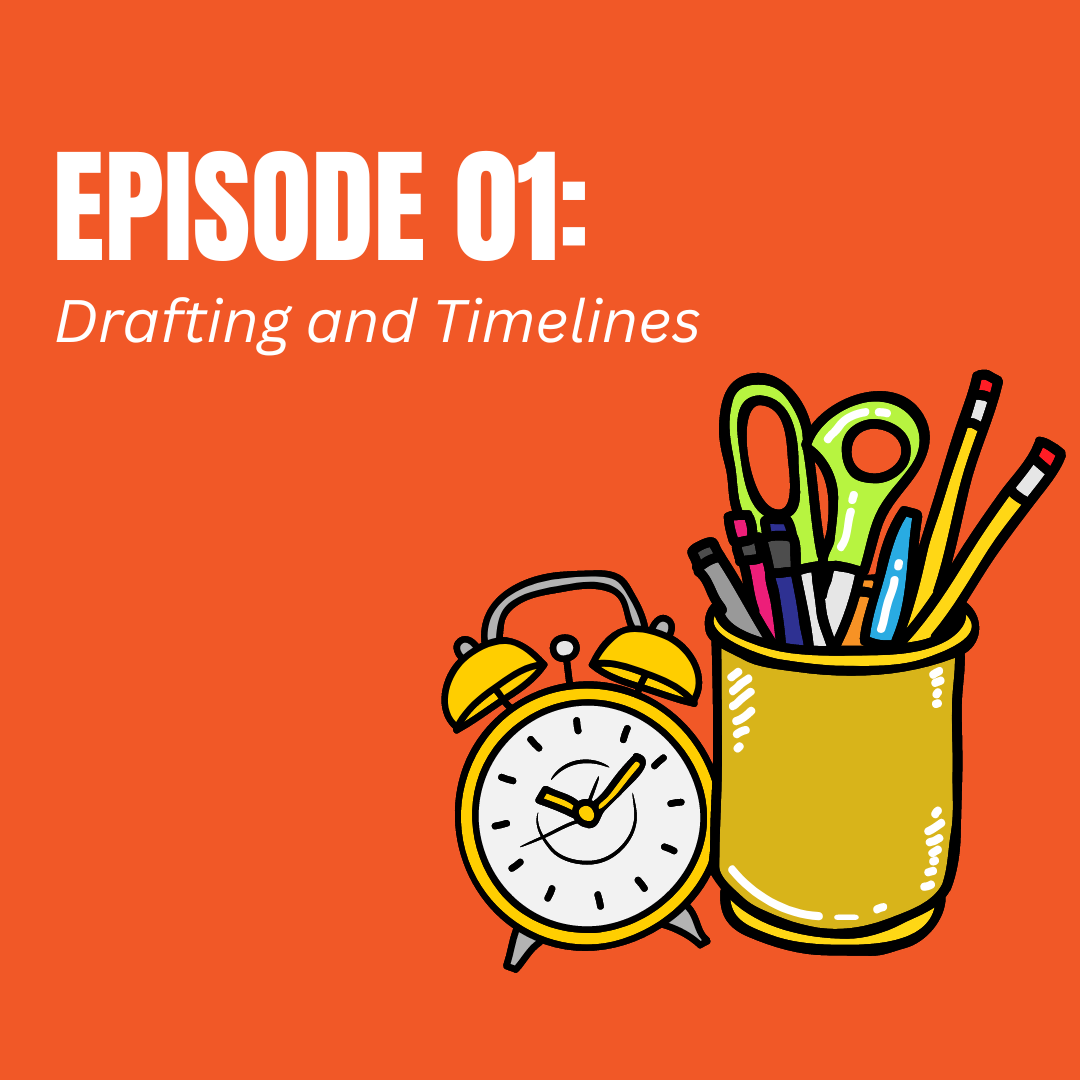EP01: Purposeful Drafts & Timelines

I was interviewing for an indie author coach position at a publishing company before I started ex42, and they asked me this in an interview:
"As an indie author, do you plan to expedite your own publishing processes?"
To which I asked, "What do you mean?" It had taken me nearly three years to figure out, write, and publish my last book. And I still wish I would've spent longer on it. There are still things I'd go back and tweak. (While I do believe there's a point of finality where you must let go, I also think it should be when your knuckles are white from hanging onto the work so tightly.)
The man told me that a fundamental part of their business model is encouraging independent authors to release books as fast as possible, pacing at two a year. "We believe indie authors should be writing the books that come easiest to them. To spread their net quickly and keep them coming. It's what makes them the most money." Verbatim. Mind you, this is a huge company that touches a lot of authors.
Telling him I radically disagreed with that approach was probably not the best thing for me to say for my own candidacy in a final interview, but I am not a liar nor a pretender. Too many independent authors fail to understand why they aren't growing into commercially recognized authors while self-publishing four books a year. If this is you, simply put, you're focusing on the wrong thing.
Disclaimer: this type of self-publishing takes time.
A core belief of mine is that if indie authors want to be taken seriously, we need to write fewer books of a higher quality. If you want to publish a book that takes you to the next step in your career, you need to have time to:
- 💡 Write a better book. (Yes, for real. A second draft won't cut it.)
- 💰 Budget for the self-publication process:
- Which allows for a complete editorial procedure
- Which allows for a targeted marketing scheme
- Which allows you to commit yourself to quality vendors
- Which allows you to not rush because of a self-imposed deadline
I understand you've been told that going slow will kill your indie career. I also understand there are genres (Wattpad romance) where printing books can help you keep an audience on a leash. I'm not focused on that. At ex42, I'm focused on indie commercial success that rivals books published traditionally. If that is what you are looking to do with your work, you're in the right place.
Must-Have #1: A Purposeful First Draft
A first draft should be messy, imperfect, and full of hope because it's been designed around a goal. (Free downloads ahead)
Must-Have #1: A Finished First Draft with Goals
You might be thinking: Yes, lindsey. Duh. But this is where so many aspiring writers fall off. They believe they need to bang out a perfect first draft that showcases so much potential and promise from pages 1 to 400. One that leaves the industry screaming: "genius" so loudly that who wouldn't want to help polish it? And that's all a draft needs, right? A little polish?
Way too much pressure. If you don't set goals before you begin, you'll drown in the abyss of it all. Let's start with setting some goals.
First Draft Goal Setting:
Boiling it into big goals that you'll need to take down to a very specific level:
- Have a rough draft of your character arc first (You too, nonfiction)
- Your POV should go through a significant transformative experience. This is the crucial element of storytelling. Whether fiction or nonfiction, we want to stick to a lens for our novel that allows a transformative POV to occur.
- Cause & Effect Outlining:
- Cut space for any scene where a bunch of stuff just happens. Delete, backspace, delete. (I'm still learning how to do this by fire, trial, and error.)
- FICTION: Every scene should cause the next scene.
- FICTION & NONFICTION: Every scene should affect the main POV's transformation or character arc. We want to keep that transformative lens in play constantly.
- FICTION & NONFICTION: Every scene should have a resolution. How did this scene change the POV or the story? Once the reader knows why it matters, it can bring us to the next scene or section.
4️⃣ FICTION 4 STEP SAMPLE:
- One flawed main character who has some specific intrinsic problem (I often have to reteach myself and am still learning how to do this properly. It's hard to figure out. Even writing my third book, I find myself returning to the basics here, but it's the most important thing to keep returning to.)
- An outline of the plot points that will test the main character's intrinsic problem (which is only brought out more by other characters)
- A Want-It-Got-It-Cant-Have-It Plot Point: The character gets what they thought they wanted, but it furthers their original intrinsic problem
- A Breakpoint: The character is forced to do things they way they didn't want to to overcome said intrinsic problem
- An Overcome Point: The character changes in a positive way regarding their intrinsic problem, but it turns out not to be the way they expected it would happen
- The plot filled in from those three critical issues, with each plot point stemming from the protagonist's intrinsic problem
- A finished first attempt that you've paced against your genre's general word count
4️⃣ NON-FICTION 4 STEP SAMPLE:
- One intrinsic problem with a singular POV lens to tell it from
- An outline of the points that must be taken to overcome that problem, sticking to the singular POV lens (which is only supported by other lenses)
- Starting with a one-sentence synopsis of each chapter
- Your book's entire target message in one sentence at the end
- A finished first attempt that you've filled in from there and paced against your genre's general word count
Using Expected Word Count to Help You Outline Your Draft
Using word count against your story can help you outline your novel. It can be easy to think that the first twenty-thousand words of your self-help novel should be introducing yourself and your life. Unfortunately, that isn't so when a self-help novel's expected word count averages fifty-five thousand words.
COMMERCIAL WORD COUNT EXPECTATIONS BY GENRE:
- 👻 Mystery/Thriller: 65k-85k
- 🌅 Literary Fiction: 60k-75k
- 💋 Romance: 50k-90k
- 📚 General Fiction: 70k-100k
- ⚛️ *Science Fiction: 85k-140k
- 💡Self Help: 40k-70k
- 🌀Poetry: 10k-30k
- 🐉*Fantasy: 80k-140k
*word count for the first book in series
Here's an example of how you can use the expected word count for your genre to outline the cadence of your first draft:
SPOILER: I'll equip you with a word-count writing calendar in the next section.

Must-Have #2: A Timeline That You Dislike
You don't hate it at least? (Free downloads ahead)
You Need To Go Slower Than You Want To
If I had a dollar for every time I got excited to complete a milestone and announced a project too early to quietly delete the post after realizing it would need to wait because my work wasn't entirely done...I'd have about five dollars.
Getting to the end of a milestone always makes the book feel so close to reality. We could almost taste it. So we try to taste it. We tell readers, "Omg, it's coming!" And then we later realize we will have to (a.) grind it out and put something up that we're not ready to release or (b.) Pretend no one heard that and go back to doing our work with a little taste of annoyance that our passion takes so damn long
This doesn't happen because we're liars or because we're being self-inflated. It happens because we're scared our readers will forget about us while we spend countless hours working on this wonderful, beautiful thing just for them. We have no way to share the work with them (this hellhole grind we're on that they'll be so proud of) until it's done. Trust me, that's a good thing.
How To Create A Timeline That You Dislike:
Creating a timeline that you dislike is key to writing a good novel. TBH: If you like the timeline, it's probably too short. Remember that over this timeline, you'll also be creating a budget for your book launch. The longer you have to save and plan, the better your book's chances are.
So, could you turn that frown upside down?
Step One: Commit to A Flexible First Draft Calendar
Based on your book's expected word count, give yourself a flexible calendar range to finish your first draft. Give yourself double the time that you think you need to finish it and commit to hitting a monthly word count that's less than what you think you can do in 30 days.
There are plenty of people on the Internet that will tell you they can crank out a first draft in two weeks and that it's f*cking awesome. Even in my hardly-employed glory days after college, I couldn't do that. And believe me, I tried.
For most of us, we work full-time. We have lives and spouses and kids and flat tires and bills and late fees for doctor's appointments that we forgot about. So don't let Timmy on Youtube tell you to crank our a first draft in thirty days if you wanna be a megamind dragon fantasy writer hero. Timmy's definitely got issues bigger than his first draft.
STEP #1 MAIN IDEA: Stick to a goal. Give yourself flexibility. And be consistent.
Use our realistic writing calendar to help:

Step Two: Editorial Calendar
Congrats! You finished your first draft! Wohoo. Pop that champagne.
- Good news 😄: You're ready for your editorial step in the writing process!
- Bad news 😦: You should give yourself much longer than the initial drafting step.
SPOILER ALERT: We're going to take a deep dive on the editorial process later in this newsletter. I'm not going to touch on it much here, but I wanted to give you an idea of why we need to go slow.
The budgeting (that we're going to discuss in the next month) is going to come into play with how this calendar is structured.
- PHASE ONE: Self-editorial process
- During this phase you rewrite the novel yourself before it gets to your editor. We will discuss this phase later in the newsletter (how to budget for one, how to select one, ect.) This part of the process is usually my favorite. I get highlighters, a printed draft, and a lot of gel pens and read the draft out loud. It's a special time to be proud of how far you've come.
- PHASE TWO: Professional developmental editing
- Again, we're going to talk about all of this later. Booking a good editor can take time & financial planning.
- PHASE THREE: Developmental re-writing process
- This is where things start to get fun!
- For my work, I usually work out a deal with my editors where I can get two developmental rounds to make sure the plot is up to snuff.
- CYCLE FOUR: Line & grammar professional editing
- With even more self-editing
- CYCLE SIX: Beta & test group reading
- Which usually results in even more self-editing
KEY TAKEAWAY: This takes way too freaking long.
Step Three: Creating a Strategic Project Budget with a Realistic ROI
This piece of the pie is going to take much longer to discuss. And I'm getting cues that you've been reading long enough and are ready for a break. 😴
We're going to delve into it strategic budgeting against a timeline over several articles. It's the single most important thing you will do for your book's chance at making waves and creating the next step in your author career. So look forward to that!
The good timeline vows:
🔊 I will not announce my book release until I'm a month away. And I'm most likely not a month away yet.
This doesn't mean you can't talk to your audience about your writing. But, contrary to those urges you have, you do not want to push any marketing effort out while we're still writing and editing. Don't even push something that looks like marketing. I pinky swear it's in your best interest.
🔊 There are plenty of ways for me to stay engaged with my audience that aren't announcing a book launch before I'm ready.
Grow that audience early. If you're desperate for a nod from them, a pulse check that you're both still alive, a good way to stay engaged is through:
- Newsletters like Substack
- Writing articles and contests on Medium & Vocal & more
- Social platforms like Tiktok and Instagram
🔊 This process takes time and I'm going to enjoy it.
One of the blessings of traditional publishing for authors is that you're forced to wait through each process. Someone is literally making you. Our downfall as indie authors is trying to go too fast. We get excited and hit publish prematurely when a few extra months and marketing dollars could've changed the trajectory of our book entirely.
And trust me, trying to correct your efforts after you've hit that publish button makes this infinitely harder. I've seen it in my clients and can promise you, it's better to just take your time.

⏭️ EPISODE TWO UP NEXT
Did you miss the introduction to Publishing Hypothesis?
🔗 Read it here.